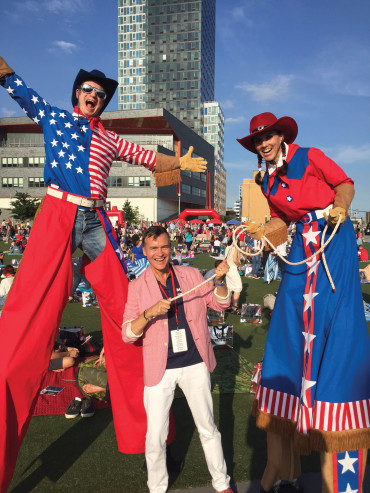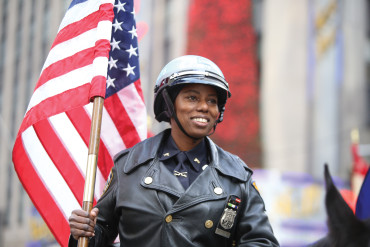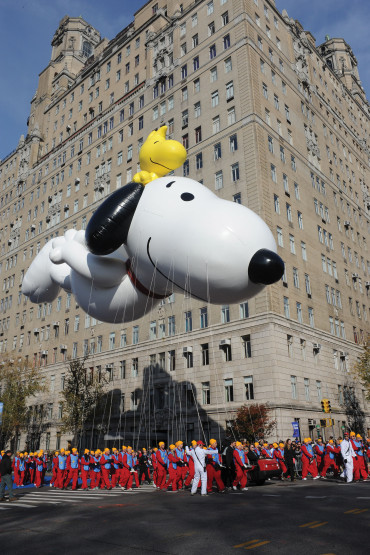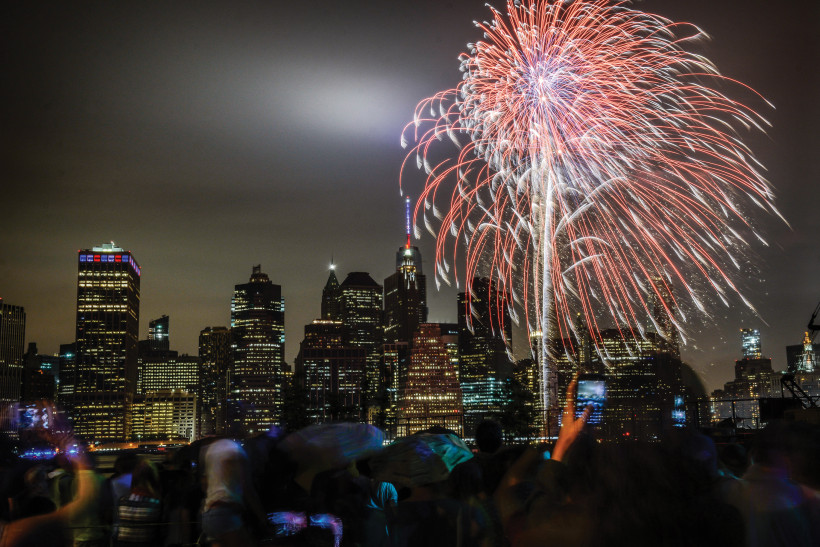Let's Have a Parade!
October 1, 2016
By
Kelley Freund

In 1924, something about Thanksgiving morning was different in New York. The flier promised clowns, cowboys and sword-wielding knights. The Old Woman Who Lived in a Shoe, Little Miss Muffett and Little Red Riding Hood. There would be four bands to accompany the six-mile march, along with a menagerie of animals from the Central Park Zoo. And let’s not forget the guest of honor, who would bring up the rear in a reindeer-driven sleigh before climbing a ladder to sit on a golden throne. The Christmas season had arrived in the city.
Ten thousand people cheered as Santa arrived at the end of the parade, in front of the newly expanded Macy’s in Manhattan’s Herald Square. As he took the throne and sounded a trumpet, Macy’s Christmastime window display was revealed and children rushed forward to see.
The Macy’s Thanksgiving Day Parade started as a way to celebrate the opening of the self-proclaimed “World’s Largest Store.” It has since turned into a beloved tradition watched by millions. And for 34 years, a William & Mary alumnus, an incurable optimist, a child at heart, was the spirit behind it.
I Believe
It may have been fate that William “Bill” Schermerhorn ’82 went on to head up the country’s biggest celebratory traditions. He was, afterall, born on the fourth of July and covered his childhood bedroom in Philmont, N.Y., with red, white and blue. Schermerhorn was a country boy who grew up amongst cows and apple trees. An “A” student, he was focused on schoolwork, church choir and piano lessons. He had a picture of George Washington over his bed. In his spare time, Schermerhorn liked to spend time by himself, taking long walks in the woods.
“But theater always gave me a chance to shine,” he says. “I would be the kid who would go to summer camp and actually have the script and the costume in my suitcase, and when I got there the first day, say, ‘This is what we’re doing.’”
Schermerhorn began working for a summer stock theater group in nearby Chatham, N.Y., when he was 12. His first show was “South Pacific,” and he claims that’s when he got the theater bug. Schermerhorn continued to work with the theater group every summer until he graduated from college.
“It really helped me in terms of becoming a lyricist and playwright,” says Schermerhorn. “My job was actor/tech, so you had to do a tech component. This could mean cleaning the bathrooms, but I found out I could write for the children’s shows. It was great training.”
As a child, Schermerhorn remembers stopping overnight in Williamsburg on family trips to Florida. There may even be a photo of Schermerhorn in little shorts and a tricorn hat. William & Mary was an obvious choice. But his love of theater took a backseat for a brief moment when he enrolled in 1978, entering as a prelaw student — a very brief moment. Schermerhorn was prelaw for about three weeks, before a chance meeting with Elizabeth Taylor (yes, that Elizabeth Taylor) steered him in another direction.
Taylor was on William & Mary’s campus campaigning for her husband, John Warner LL.D. ’81, a Republican Senate candidate from Virginia. While many people at the fundraiser seemed afraid to approach her, Schermerhorn went right up and the two started chatting. He talked to her about being a pre-law student, but having more of a love for theater and acting. “She told me I should do what my heart wanted to do. I wrote a note home that night to my parents saying, ‘Dear Mom and Dad, Elizabeth Taylor said…’”
Schermerhorn changed his major to history but lived at Phi Beta Kappa Hall, working with the Backdrop Club, the Canterbury Players with Howard Scammon ’34, and performing in shows like “Saint Joan” and “Joseph and the Amazing Technicolor Dream Coat.”

VARIETY SHOW: Drill team girls fill Sixth Avenue during Macy’s Thanksgiving Day Parade.
Photo © Andy Katz/Pacific Press via ZUMA
Won’t You Join Our Parade?
From “Saint Joan” to … selling underwear and leather coats? Schermerhorn took the part-time job at Macy’s to help pay his rent as he forged his way as an actor in New York in 1982. While working on a show in Brooklyn, someone suggested to Schermerhorn that if he was going to work at Macy’s, he should work in the parade office. When he went up for his interview, the parade’s executive producer, Jean McFaddin, convinced Schermerhorn that he really wanted a full-time job.
Schermerhorn progressed through the ranks at Macy’s. He started out answering phones, then began asking if he could write scripts for various events. He soon found himself writing for the Fourth of July Fireworks Spectacular when they were broadcast on WPIX and working on speeches for various executives as needed. In 2000, he was named vice president/creative director for the Macy’s Parade & Entertainment Group, the team that brings the Macy’s Thanksgiving Day Parade and the Macy’s Fourth of July Fireworks to life for the world.
The parade is the second-oldest Thanksgiving parade in the United States. When Macy’s flagship store in Manhattan’s Herald Square had expanded to cover an entire city block, the department store decided to celebrate the one million square feet of retail space by throwing New York City a parade on Thanksgiving.
A lot has changed since that first parade in 1924. The growls from the zoo animals — who did not care for their six-mile trek — frightened the children watching, so they were soon replaced with balloons. Felix the Cat was the parade’s first giant balloon in 1927. In 1928, he was inflated with helium, and without a plan to deflate the balloon, parade organizers simply let Felix fly off into the sky. For the next few years, the parade continued to let balloons fly off, but with a return address written on them so that whoever found the balloon could return it for a prize from Macy’s. (Macy’s is now the world’s second-largest consumer of helium behind the United States government.)
Everyone has their favorites, from Mickey (who debuted in 1934) to Snoopy (who has been in the most Thanksgiving Day parades) to Dino the Dinosaur (who was inducted into the American Museum of Natural History in 1975 as an honorary member).
“I marvel at the technology of it,” says Schermerhorn, whose favorite balloons include Charlie Brown and Mickey. “Take a balloon like Spongebob. Balloons aren’t supposed to be square. If you ever saw inside the Spongebob balloon, the rigging of ropes that are all crisscrossing to pull him into shape, it’s quite an effort. Or the sculptural muscles of the superheroes and how that all comes to be. The patterning is so important in how that all works. It’s art and science.”

Bill Schermerhorn ’82 wrangles the talent before Macy’s Fourth of July Fireworks Show.
Photo by Dan Dutcher
Today, in a former Tootsie Roll factory in Hoboken, N.J., across the river from New York City, those challenges are overcome by the Macy’s Parade Studio, whose balloonists figure out how to turn a square-shaped sponge into a balloon.
But the inflatables are just part of the big picture. In addition to balloons and floats, the parade also features live music and other performances, including numbers from some of the hit Broadway shows of the year. College and high school bands from across the country also participate in the parade, and the Rockettes have performed annually since 1957.
“I compared my role to being a chef,” Schermerhorn says. “I would bring together all the ingredients for a great show. I would help pick the marching bands, the talent selection, I worked with all the Broadway shows and what their performances were going to be and how their performances would be best for the telecast. I would put that whole lineup together. Contrary to popular belief, we didn’t just throw things up in the air, and whichever way they came down was the way they went down the parade route.”
Marching bands are selected in March and April of the year before their scheduled parade, so they have time to fundraise. “It would sort of be like the Publisher’s Clearinghouse,” Schermerhorn says. “We would go surprise the school and announce to the kids that they were going to be in the parade. It was so much fun being there. I like being face-to-face with people and it was great to actually meet the community.”
While working as parade director, Schermerhorn would begin planning the parade lineup in April, changing and tweaking all the way through until people told him he had to stop. “If you make a change in October,” Schermerhorn says, “it affects a lot of people.”
For many of his 34 years with the parade, on Thanksgiving Day Schermerhorn would sit in the truck with NBC, beside the executive producer and right behind the director, calling units in and out from the telecast area. But the last two years, he began concentrating more on the live event, standing at the starting area, asking every single clown and every single group to please join the parade. He then got in a golf cart and drove up and down the parade route seeing what was happening. While every parade was different, the end goal was always the same: get Santa there on time — no matter what.
“We’ve been out there in pouring rain and snow,” says Schermerhorn. “Once you’re wet, you’re wet, so just keep going. Those rainy 36-degree days were not as much fun as those sunny Thanksgiving mornings, but you just did it.”
Fifty million people watch the parade on television each year, while 3.5 million New Yorkers and tourists line the parade route. “What’s great about the Macy’s parade is that it’s always reflected the best in American pop culture,” says Schermerhorn. “I’ve always said if you named three talents and three balloons, you could probably guess pretty close to what year it was. You’re always learning what’s new. It keeps you young to have to know who the latest teen groups are, or what’s the nursery school set watching. But at the same time, it’s important to keep things that everyone else wants to see as well. It’s one of the last great variety shows on television. I think we’ve done a good job of preserving the old and enhancing with the new.”

A NYPD officer rides in the Macy’s Thanksgiving Day Parade.
Photo Andy Katz/Pacific Press via ZUMA Wire
Touch the Sky
As creative director for the department chain, Schermerhorn also coordinated the Macy’s Fourth of July Fireworks Spectacular. Macy’s fireworks display first decorated the sky above New York Harbor in 1958, but not on July 4. The event took place on July 1 as a celebration of the department store’s 100th anniversary. In 1976, Macy’s partnered with the Walt Disney Company to celebrate the U.S. bicentennial with a fireworks display that has since become an annual tradition. In 1991, it was televised locally on WPIX for the first time and went on to become syndicated throughout most of the United States until 1999, before being broadcast nationally by NBC in 2000. Celebrities and notable figures began to take part in the show, including Jerry Seinfeld, Elmo and President Bill Clinton. It has since evolved into the largest ongoing Independence Day pyrotechnic show in America, a two-hour, nationally broadcast event featuring the biggest names in music. Nearly three million people watch each year. The event celebrated its 40th anniversary this past July, Schermerhorn’s last year with the show.
For Schermerhorn, planning for the Fourth of July Spectacular always started with the music. He would put the score together, whether it was picking the best of CDs or working with artists, which would have to be completed by February. His team would then work with a fireworks company to coordiante the music with the pyrotechnics.
“The technology has improved so it’s all run by computers, but there are still people behind it,” says Schermerhorn. “The person still has to program it to make the firework go boom right on the boom of the music. I marvel at all of that; I don’t know how they do it — just beautiful moments that dazzle.”
In April, Schermerhorn and his team would begin to work with NBC to create the rest of the show. “I sort of lived this reverse life, where around fourth of July, I was starting to hum Christmas tunes and around Christmas I was singing ‘The Star-Spangled Banner,’” says Schermerhorn.
But despite his calendar being a little off, Schermerhorn considers his job as a dream one. “I’m lucky in that I got to work with the best people in the industry,” he says of his jobs with the parade and the fireworks. “That not only means the biggest names in talent, but also the best directors, choreographers, writers, musicians. It was a dream job. I’m proud of my history with two of the biggest events this country has. I believe holding true to keeping it a celebration and a joyful experience. I always create events that I am proud of and that I like and I hope everyone else does to.”

Snoopy and Woodstock: Snoopy holds the record for most appearances and most balloon versions.
Photo © Callahan/Ace Pictures via ZUMA Press
It’s About Us
Schermerhorn has received four Daytime Emmy nominations for Original Song, winning two years in a row: once for “Yes, Virginia (There’s a Santa Claus)” in 2011 and once for “(Won’t You) Join Our Parade” in 2012.
“Winning an Emmy, in terms of being acknowledged by my peers for something I love doing, is an accomplishment I’m so proud of,” says Schermerhorn. “It’s truly an exciting evening when you hear your name that you’ve won. So many people helped me get to that point.”
“The Hope of Christmas,” a recording of his Christmas songs; a vinyl edition will be released for the 2016 Christmas season. He worked on “Swing Wings,” a musical saluting the men and women of the Radio Production Unit of the Army Air Corps during WWII and “Yes, Virginia The Musical,” a Macy’s project that supports art in the public schools by providing the “Yes, Virginia” musical royalty-free with additional financial grants to middle schools across the United States.
“I love telling stories,” says Schermerhorn. “Life is a musical, so when I can capture my emotions, what I’m feeling, what I want to say through a song, I think there’s something really special in that.”
Schermerhorn retired from his position as creative director at Macy’s this past year. But he’s not done being creative. “I’ve got new stories to tell, new songs to write and new playgrounds to play in,” he says.
One of those stories has to do with William & Mary. Using his years of experience in parade operations and the creative side of things, Schermerhorn is serving as a consultant for William & Mary’s 2016 Homecoming Parade to be held Oct. 14.
Coordinating with students and the Alumni Association, Schermerhorn seeks to create a unique expreince for parade-goers, one that incoporates the talents of campus organizations and alumni groups. “My goal there is to bring the whole William & Mary community together, whether it’s the students, the alumni, or the neighbors to show off the spirit and pride of William & Mary,” Schermerhorn says. “I’m looking forward to being there. It will be my first Homecoming because before all this, I’ve always had to get ready for a rather big parade.”
In the spring, Schermerhorn will be working with the Theatre Department developing a musical through one of the classes. He will be working with Denise Wade ’83, who will be choreographing the show. Wade choreographed Schermerhorn in the late ’70s when they both were in the Theatre Department as students. With the musical, he’s working out a deal where the Theatre Department will get part of the residuals henceforth because of their help in shaping the musical.
“I’m excited to play an active role in the William & Mary community with these projects,” says Schermerhorn. “Together, we’re all going to create a really entertaining event and I can’t wait to get started.” (To see more of Schermerhorn’s latest projects, visit williamschermerhorn.com.)
Schermerhorn still likes to go on long walks in his spare time. He and his husband, Dan Dutcher (who is a publicist for the arts), have been together 28 years, and married for the last two. They met when Dutcher came to audition for a Christmas quartet. He had on his résumé that he had done children’s theater and Schermerhorn asked Dutcher if he liked the shows he had done there. It was a good thing Dutcher said yes — Schermerhorn wrote them.

LIGHT SHOW: This past summer, the Macy’s Fireworks Show celebrated its 40th anniversary. It was also Schermerhorn’s last year working on the program.
Photo © Angel Zayas/Pacific Press via ZUMA Wire
Free to Dream
On the morning of his last Macy’s Thanksgiving Parade, Schermerhorn, just as he did the other 33 years, walked to work up Central Park West. It was just 4:30 a.m., but New Yorkers were already starting to set up their chairs on the sidewalk along the parade route. Everyone said Happy Thanksgiving as he passed, not knowing that the spectacle they would see in a few hours was his creation. It was moments like this, the excitement he felt on those streets, the sense of joy, that kept Schermerhorn coming back year after year.
Other moments happened during rehearsal, like when a Broadway performer, ignoring warnings that he would slip, tap danced all-out in the pouring rain, having a wonderful, care-free time, like a three-year-old splashing though a puddle.
Or when the city of New York told Macy’s management to go ahead with the parade after Sept. 11, 2001, because the event was so symbolic. The Statue of Liberty lead the march for the first time and the city came together in remembrance.
On the surface, the Macy’s Thanksgiving Day Parade is about the arrival of the Christmas season. But to so many, it’s more. It’s a day to watch balloons fly down the street, a day we can all believe in Santa Claus. It’s an excuse to be a kid again. A day to be an optimist, just like the parade’s organizer of 34 years.
“There’s a child deep inside of me that I hope I never outgrow,” Schermerhorn says. “It’s not a naïve way of looking at life, but it is an optimistic way of looking at life. Hopefully I bring that to whatever I create. When we talk about the parade being for the child in all of us, I really mean it. It’s a moment when everyone can come together and celebrate the best of who we are. There’s a comfort to it because it’s a tradition, but it never gets old. I think people want those moments. Especially with the fourth of July, we celebrate our diversity and who we are as a nation. In the parade, everyone becomes a kid as balloons fly down the street. Whether it’s Snoopy for a certain generation, or it’s Pokemon for another, it just unites us all in that moment, and I think that’s what people love.”